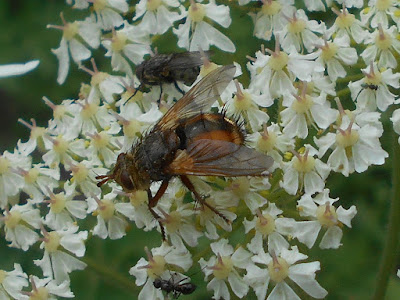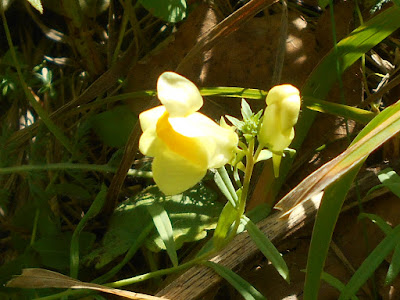I have recorded 168 invertebrates on the site so far. There will be many more but they may take a little teasing out. Beetles need work on them and I may have to put down some logs or perhaps a bait of some kind. However, on my visit today I concerned myself mainly with plants.
Hogweed is still flowering profusely and attracting a range of flies such as this tachinid fly, Tachina fera. This handsome insect is always common but seems to have been unusually abundant this year.
 |
Hogweed attracts many specimens of Tachina fera.
Byfield Pocket Park, 23 September, 2019
|
Rosebay Willowherb, Chamerion (Chamaenerion) angustifolium also remains in flower but is of little interest to flies. Instead a dozen or so bees were busy harvesting pollen and nectar. It is an asset to many insects but a curse to the pocket park management team, spreading aggressively via its rhizomes.
 |
Rosebay Willowherb is both an asset and a curse.
Byfield Pocket Park, 23 September, 2019
|
And of course White Dead-nettle, Lamium album. It may well flower throughout the winter and, on warm winter days, attract the occasional bumblebee.
 |
Ever reliable, Lamium album can be found in flower throughout the
year. Byfield Pocket Park, 23 September, 2019
|
There was a little Hedge Woundwort, Stachys sylvatica, present too. It is, like the Deadnettle, a member of the mint family, Lamiaceae, but whereas mint, lavender, rosemary and other mint relatives have a pleasing fragrance when rubbed, the smell of Hedge Woundwort is thoroughly unpleasant. Yuk!
 |
Beautiful in its sombre colours, but the foul smell of Hedge Woundwort
bars it from the garden. Byfield Pocket Park, 23 September, 2019 |
Also present was a tiny amount of Yellow Toadflax, Linaria vulgaris. Around eight species of Linaria have been recorded in Britain but this species is the only one likely to be native. It's kinship to snapdragons - Antirrhinums - is obvious, but Linaria species possess a long spur at the base of the flower.
 |
| Yellow Toadflax. Byfield Pocket Park, 23 September, 2019 |
I remember them well from my childhood but applied the same name to them as antirrhinums, referring to them as 'bunny rabbits'.
Two plants not in flower were of some interest. The leaves of a Lesser Burdock, Arctium minus, had been mined by the larvae of the fly, Phytomyza lappae, common and hardly exciting but a new record for the site.
 |
The mines of Phytomyza lappae often disfigure Burdock leaves.
Byfield Pocket Park, 23 September, 2019
|
Even less exciting was a clump of Horse-radish, Armoracia rusticana, but its presence reminds us of the origins of the pocket park. Its position marks the site of Byfield railway station, and like most such stations, the station-master had a vegetable plot beside his domain. His pay (and it was always a he) was hardly generous and the vegetables, cultivated at quiet times, were probably welcome.
The leaves of Horse-radish look rather like those of a Dock, but it is quite unrelated. It is in fact a member of the cabbage family, Brassicaceae. It seems to have originated somewhere in the east Europe - west Asia region and is completely sterile. So instead of being propagated by seed the plant is grown from chunks of the rootstock, not unlike rhubarb. All parts of the plant contain sinigrin, making the plant technically poisonous, but although animal deaths have been reported from its consumption, human cases are very rare. Like maize and broad beans, the plant is unknown in the wild except as an escape from cultivation.
 |
Tall clumps of Horse-radish are usually easy to spot but here it was growing
unobtrusively among common weeds. Byfield Pocket Park,
29 September, 2019
|
So this plant has long outlived the long-defunct railway and its employees, growing unobtrusively among Dandelions, Wood Avens and other weeds.
No comments:
Post a Comment